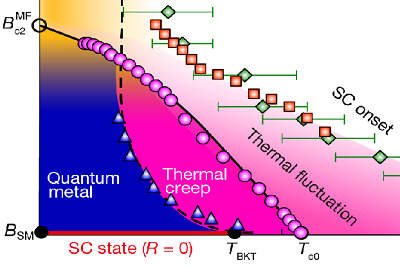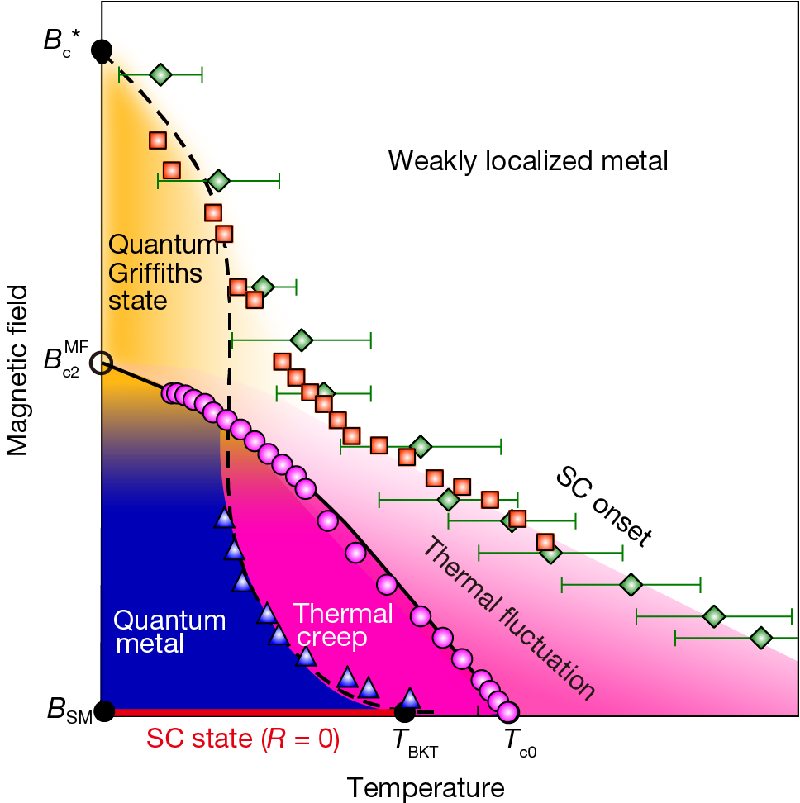Quantum fluctuations in 2D superconductors give rise to novel electronic phases Setting sights on superconducting devices for quantum computing


The superconducting state with zero electric resistance is realized only under a weak magnetic field (red line). In the extremely low-temperature region, as the magnetic field is gradually increased from the zero magnetic field, the state changes in the following way: superconducting state (red line) to quantum metal state (low temperature / low magnetic field region; blue region) to quantum Griffiths state (low temperature / high magnetic field region; orange area) to insulator state changes. On the high-temperature side, it is in a state due to thermal fluctuation (high temperature / low magnetic field area: pink area).
© 2018 Yu Saito.
A team of researchers at the University of Tokyo and their collaborators developed a new kind of transistor called an electric double layer transistor (EDLT). This development could prove pivotal to research into two-dimensional (2D) superconductors and for creating superconducting devices for ultra high-speed quantum computation. The researchers fabricated the structure using an ionic liquid as an insulating layer on which they grew single crystals of high-quality molybdenum disulfide (MoS2) and zirconium nitride chloride (ZrNCl). It was with these crystals that researchers could realize 2D superconductivity on the topmost layer with 1-2 nm of a material and which exhibits minimal disorder. Furthermore, they discovered when applying a magnetic field out of the plane of those 2D superconductors that two unique quantum states appear between superconducting (ON) and insulating (OFF) states at low temperatures. These results will not only become an important cornerstone for pioneering new research fields of 2D superconductors, but also superconducting devices for future ultra high-speed quantum computation. It is expected to become an important knowledge in developing cutting-edge hardware such as circuits.
In modern society the scope of highly integrated electronic devices advances rapidly, so research into things like nanoelectronic devices is very attractive. One particular area of interest is the integration of superconductors into hardware to produce next-generation quantum computing technology such as superconducting qubits. Therefore, there’s demand to investigate the fundamental physical properties of superconducting thin wires and films, which are indispensable for the integration of superconductors into hardware devices. However, in ongoing studies of superconducting thin films we are not able to clarify the intrinsic properties of 2D superconductors. This is due to strong disorder from impurities, defects, and an amorphous nature that unintentionally occurs during sample preparation. This situation has been a bottleneck that limits the direction of the academic understanding of 2D superconductivity and device application based on superconducting thin films.
The research group led by graduate student Yu Saito and Professor Yoshihiro Iwasa at the Graduate School of Engineering at the University of Tokyo and their collaborator prepared EDLT structures using high-quality single crystals of ZrNCl and MoS2 by the “Scotch tape method” – this is literally what it sounds like: Scotch tape is used to separate a thin layer of a weakly bound material from a larger sample of it. In this EDLT structure, electrons are accumulated on the topmost layer due to a strong electric field, which minimizes the influence of disorder. Thus, it’s possible to artificially create an ideal ultrathin 2D electron system with a thickness of 1-2 nm.
It’s the discovery of these two quantum states between superconducting and insulating states that really piqued the researchers interest, though. These new quantum states are realized for the first time through the combined effects of two dimensionality, quantum fluctuation, and weak disorder, which were not observed in conventional highly disordered superconducting films. The research group also succeeded in precisely controlling these special quantum states with magnetic fields and constructed a comprehensive magnetic field-temperature phase diagram, which may prove useful to future researchers on the subject.
Papers
Yu Saito, Tsutomu Nojima, Yoshihiro Iwasa, "Quantum phase transitions in highly crystalline two-dimensional superconductors," Nature Communications: February 22, 2018
Link (Publication )
)
Related links
- Graduate School of Engineering

- Department of Applied Physics, Graduate School of Engineering

- Laboratory of Iwasa, Department of Applied Physics, Graduate School of Engineering






